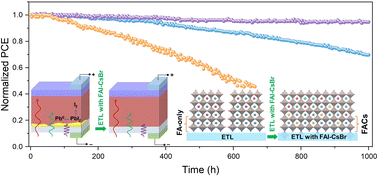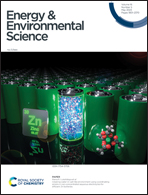Elimination of unstable residual lead iodide near the buried interface for the stability improvement of perovskite solar cells†
Abstract
In perovskite solar cells, the formation of residual/excess lead iodide (PbI2) in the perovskite film is detrimental to device stability. However, the understanding of the effect of residual/excess PbI2 and its distribution on perovskite degradation is still insufficient. Herein, we verify that the existence of residual PbI2 near the buried interface largely deteriorates perovskite stability. By using a pre-embedding mixed A-cation halide strategy, the residual unstable PbI2 near the buried interface is transformed into a more stable 3D perovskite for stability improvement. Moreover, this strategy could balance the lattice strain of the formamidinium-based perovskite near the buried interface, suppress the detrimental α to δ phase transition and improve perovskite phase stability. As a result, promising power conversion efficiencies of 24.26% and 20.97% are obtained for perovskite solar cells and modules, respectively. In addition, the solar cells maintain 94.7% of their initial efficiencies after operating for 1000 hours under one sun illumination.



 Please wait while we load your content...
Please wait while we load your content...